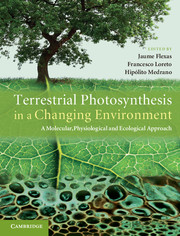 Terrestrial Photosynthesis in a Changing Environment
Terrestrial Photosynthesis in a Changing Environment Book contents
- Frontmatter
- Contents
- List of contributors
- Preface
- Acknowledgements
- List of abbreviations
- 1 Terrestrial photosynthesis in a changing environment
- Part I Photosynthesis
- Part II Measuring photosynthesis
- Part III Photosynthetic response to single environmental factors
- Part IV Photosynthesis in time
- Part V Photosynthesis in space
- Part VI Photosynthesis in a global context
- 33 Photosynthetic water-use efficiency
- 34 Global change and photosynthesis
- References
- Index
34 - Global change and photosynthesis
Published online by Cambridge University Press: 05 March 2013
- Frontmatter
- Contents
- List of contributors
- Preface
- Acknowledgements
- List of abbreviations
- 1 Terrestrial photosynthesis in a changing environment
- Part I Photosynthesis
- Part II Measuring photosynthesis
- Part III Photosynthetic response to single environmental factors
- Part IV Photosynthesis in time
- Part V Photosynthesis in space
- Part VI Photosynthesis in a global context
- 33 Photosynthetic water-use efficiency
- 34 Global change and photosynthesis
- References
- Index
Summary
The phrase global change is generally associated with alterations of climate (temperatures, fluctuations in precipitation, etc.) that stem from changes in atmospheric composition. In reality, global change also encompasses more than changes in climate or atmospheric composition; any global-scale change that influences biota directly or indirectly can be considered global change. Global change has influenced the biosphere throughout geological time, with changes occurring over periods that allow for either species to evolve to these changes when they occur over long periods, to adapt or acclimate to the changes or to perish when neither of the previous two responses is effective. Although we are currently in the midst of abrupt global change, it certainly is not the first time that rapid global change has occurred. What differentiates the current changes to our planet from all other global-change events is that these abrupt changes are brought about through anthropogenic influences and that they are occurring more rapidly than in previous occasions.
One of the major challenges of a chapter focused on plants and global change is that the topic is extensive. Many chapters of this book focus on photosynthesis responses to most of the predicted global-change scenarios, and entire volumes can be devoted to these and other global-change scenarios. Further, many reviews have been published that address photosynthetic responses to single environmental-change factors (Ceulemans et al., 1999; Saxe et al., 2001; Ainsworth et al., 2002; Long et al., 2004; Ainsworth and Long, 2005; Hikosaka et al., 2006; Sage and Kubien, 2007; Wittig et al., 2007). Our goals in writing this chapter are: (1) to provide a synopsis of global-change trends; (2) to identify the potential impacts of these trends on photosynthesis; (3) to identify the potential for photosynthesis to mitigate global change; and (4) to present ecosystem and general-circulation models as predictors of the interactions between plants and global change.
- Type
- Chapter
- Information
- Terrestrial Photosynthesis in a Changing EnvironmentA Molecular, Physiological, and Ecological Approach, pp. 537 - 545Publisher: Cambridge University PressPrint publication year: 2012


